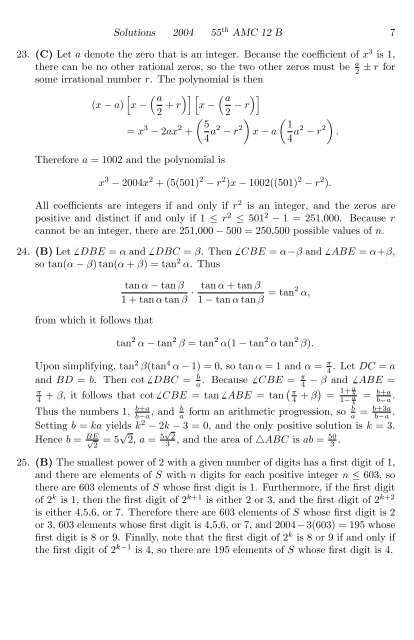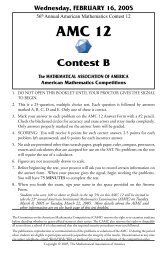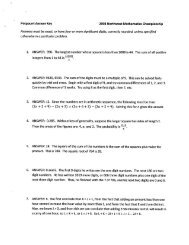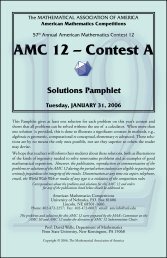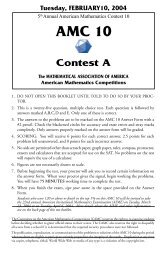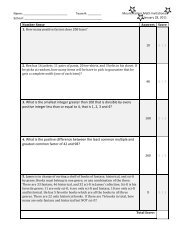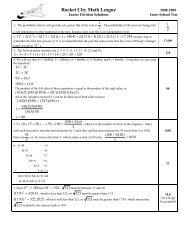2004 AMC 12B Solutions
2004 AMC 12B Solutions
2004 AMC 12B Solutions
You also want an ePaper? Increase the reach of your titles
YUMPU automatically turns print PDFs into web optimized ePapers that Google loves.
<strong>Solutions</strong> <strong>2004</strong> 55 th <strong>AMC</strong> 12 B 723. (C) Let a denote the zero that is an integer. Because the coefficient of x 3 is 1,there can be no other rational zeros, so the two other zeros must be a 2 ± r forsome irrational number r. The polynomial is then(x − a)[x −( a)] [ ( a)]2 + r x −2 − r ( ) 54 a2 − r 2 x − a= x 3 − 2ax 2 +Therefore a = 1002 and the polynomial is( 14 a2 − r 2 ).x 3 − <strong>2004</strong>x 2 + (5(501) 2 − r 2 )x − 1002((501) 2 − r 2 ).All coefficients are integers if and only if r 2 is an integer, and the zeros arepositive and distinct if and only if 1 ≤ r 2 ≤ 501 2 − 1 = 251,000. Because rcannot be an integer, there are 251,000 − 500 = 250,500 possible values of n.24. (B) Let ̸ DBE = α and ̸ DBC = β. Then ̸ CBE = α−β and ̸ ABE = α+β,so tan(α − β) tan(α + β) = tan 2 α. Thusfrom which it follows thattan α − tan β1 + tan α tan β · tan α + tan β1 − tan α tan β = tan2 α,tan 2 α − tan 2 β = tan 2 α(1 − tan 2 α tan 2 β).Upon simplifying, tan 2 β(tan 4 α − 1) = 0, so tan α = 1 and α = π 4. Let DC = aand BD = b. Then cot ̸ DBC = b a . Because ̸ CBE = π 4 − β and ̸ ABE =π4 + β, it follows that cot ̸ CBE = tan ̸ ABE = tan ( π4 + β) = 1+ a b1−= b+aab b−a .Thus the numbers 1, b+ab−a , and b a form an arithmetic progression, so b a = b+3ab−a .Setting b = ka yields k 2 − 2k − 3 = 0, and the only positive solution is k = 3.Hence b = BE √2= 5 √ 2, a = 5√ 23 , and the area of △ABC is ab = 50 3 .25. (B) The smallest power of 2 with a given number of digits has a first digit of 1,and there are elements of S with n digits for each positive integer n ≤ 603, sothere are 603 elements of S whose first digit is 1. Furthermore, if the first digitof 2 k is 1, then the first digit of 2 k+1 is either 2 or 3, and the first digit of 2 k+2is either 4,5,6, or 7. Therefore there are 603 elements of S whose first digit is 2or 3, 603 elements whose first digit is 4,5,6, or 7, and <strong>2004</strong> − 3(603) = 195 whosefirst digit is 8 or 9. Finally, note that the first digit of 2 k is 8 or 9 if and only ifthe first digit of 2 k−1 is 4, so there are 195 elements of S whose first digit is 4.


